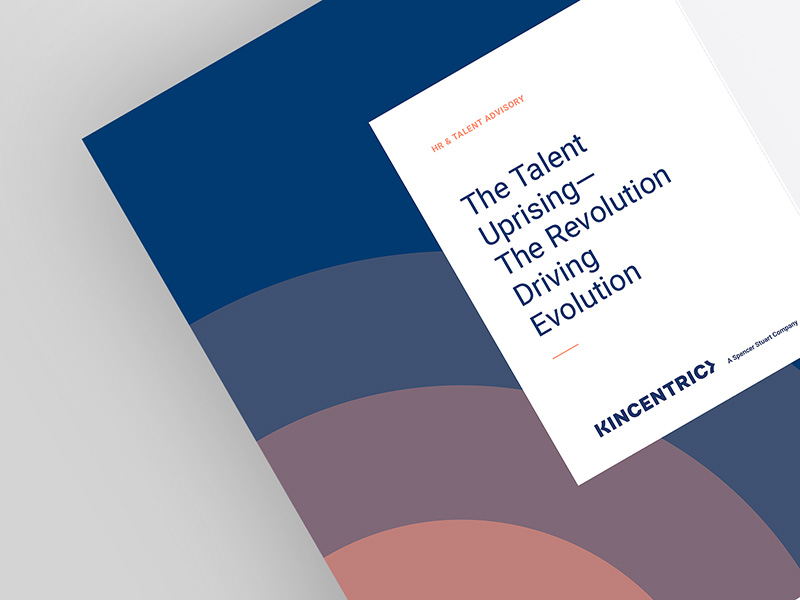
The disruption caused by the pandemic has resulted in a sea change in how, when and where work gets done, and the job market will never be the same. Now, as vaccination rates rise and pandemic restrictions ease, many organizations that are eager to go “back to normal” must contend with the fact that employees are no longer willing to return to pre-pandemic ways of working. This has led to a power shift and resulted in a “Talent Uprising,” creating a world in which employees have a stronger hand in dictating the terms of employment, allowing them to demand more flexibility in how, when and where they work; increases in salary and benefits; and even changes in culture and progress in DE&I initiatives.

This Talent Uprising should not be seen simply as an employee revolution but as a driving force for organizational evolution. Smart organizational leaders will leverage the learnings from the last year and a half, building on the agility and momentum gained to create meaningful changes in the workplace, the workforce and the work itself, elevating the employee experience to create a culture in which employees feel inspired, respected, connected and committed.
As organizations see a return to pre-pandemic operational levels—or even experience unexpected growth—many are struggling to hire and/or retain the talent necessary to sustain their business. Our work with our client partners supports this. In analyzing Q2 21 client data spanning more than 600,000 survey responses, clients have reported significant drops in their belief that they are attracting (-6pts) and retaining (-7pts) the talent needed to achieve their business goals (compared to pre-COVID baselines from 2019). This has been exacerbated by the fact that large numbers of furloughs and layoffs have led many employees to retire early, change careers, start their own business, or join the “gig economy,” while others are unwilling to return to work due to ongoing concern for their health and safety or difficulty securing reliable childcare and balancing the needs of their families.
The majority of those who have remained at their jobs over the course of the pandemic found themselves forced to pivot to new ways of working almost overnight. The switch to remote work has often made team building and employee bonding a more difficult proposition and has resulted in blurred lines between work and home life, longer working hours and more meetings, increasing the risk of burnout and jeopardizing personal well-being. Again, we see this reflected in our client data, in which perceptions of work-life balance dropped -7pts from 2019 scores.
Remote working also created a need for people managers to develop new skills to effectively manage remote and hybrid teams. The virtual environment demands a more caring, connected and engaging leadership style versus the traditional “command and control” model. In the wake of the pandemic, employees report feeling more connected to their manager, and seven out of 10 feel their manager has become more effective at creating a positive team atmosphere (compared to 2019).
Finally, the old model in which employers controlled when, where and how job opportunities are positioned in the market has changed. The last 18 months have demonstrated that many jobs are no longer location-constrained and can be structured to accommodate employees working from almost anywhere in the world.
For these reasons, many organizations now find themselves at a crossroads, struggling to weigh the benefits of pre- and post-pandemic operating models. On the one hand, employees have successfully demonstrated that they don’t need to be in the office on a regular basis to be productive, and many workers report feeling more productive—whether at home or in the office—when they have more flexibility in the way they work. Remote work has also provided employers access to a much larger pool of talent, allowing employers to search for the best candidates from literally anywhere in the world. However, working remotely can often result in disengagement and disconnection, making it more tempting for employees to search elsewhere for not only the right level of flexibility and compensation, but also the right culture, connection and community they desire.
The Talent Uprising presents one of the greatest opportunities ever to create meaningful changes in not just the workplace, but in the workforce as well as in work itself. What, then, should organizations consider as they look to create a new work environment that best meets the needs of the employees as well as the business?
You will need to have a strategy in place to address the needs of a hybrid workforce. As more organizations move to a hybrid model, direction should be given around when and where employees will work on-site. Consider instituting set schedules, taking into account the needs of teams as well as individuals, and communicate policy clearly. Workplaces should be adapted to accommodate social distancing, with fewer private offices and more open spaces that are best used to support collaboration, networking and onboarding. Maximize tools and technologies such as video conferencing and virtual whiteboards to enable both on-site and remote workers to have consistent experiences and opportunities for meaningful collaboration. Make sure you are taking the steps necessary to ensure the health, safety and engagement of both on-site and remote employees and strive to provide as much flexibility as possible when it comes to determining when, where and how work gets done. Examine your people strategies, processes and procedures to ensure they are equitable for remote as well as on-site employees and make sure remote employees are not overlooked for stretch assignments or promotional opportunities. Lastly, communicate early and often. These are challenging times and providing employees with timely updates on changes to strategy and work models can alleviate some of the anxiety that comes with uncertainty.
Given the profound changes over the last year and a half, you may need to re-evaluate the importance of certain functions to determine those truly critical to the business in the wake of the pandemic. An example of this are the frontline workers in the retail and hospitality industries, without whose presence and continued performance entire organizations were destined to fail. Once the most business-critical employees and functions have been identified, double down on retention and engagement efforts. And remember, sometimes turnover isn’t always bad, unless you are hemorrhaging high-potential employees or are unable to maintain operations.
Consider candidates who come from nontraditional recruitment centers such as the military, community colleges and remote or nonurban locations. Look for skills and alignment with culture versus years of experience within your specific industry. Utilize freelancers or contract workers for “tour of duty” projects with a definitive end date. Once you hire, be sure to adapt your onboarding program to create strong connections early in an employee’s tenure. Conversely, take care not to alienate exiting employees. Many employees left the workplace during the pandemic due to difficulty balancing the needs of their families. Women are particularly over- represented in this group. And while schools may be back in session and childcare more readily available, many have no desire to return to work full-time, but rather seek part-time, contingent or freelance opportunities. Don’t overlook the talent available in these employee populations. You never know when a former valuable employee might look to return. Leverage social media and professional organizations to maintain a connection with these potential “boomerangs.”
Ensure your leaders have the right professional skills as well as the right people skills to lead through a return to the workplace, particularly if work will now be done in a hybrid environment. Are they demonstrating care and compassion? Are they connecting with their team members—in person or remote? And if so, are they leveraging those more intimate relationships with their people to identify, explore and solve challenges and issues?
There has never been a more important time to listen and respond to employees. But it’s not just about measuring engagement; it’s about using employee feedback to drive talent and business decisions. Identifying and shaping the moments that matter for the segments that matter across your organization will be a must for organizations to successfully take advantage of the Talent Uprising. This means asking the right questions to the right segments at the right time, which may require changes to your continuous dialogue program. Blending quantitative and qualitative feedback through products such as natural language processing (NLP) technology will ensure a full view of the employee voice is being captured.

Make sure your succession plans are intentional; go deep into the organization; are based on data; and represent diversity in ethnicity, gender, culture and experience. Evaluate and assess your pool of leaders to ensure the right talent match for your organization. Who is in it for the long haul? Do they have the agility needed to adapt to change effectively? Does their EQ match their IQ? Do they have the right people skills as well as professional skills?
Employees want to chart a course for their future, yet just under half (45%) of all survey respondents do not feel positive regarding career opportunities at their current organization. If you don’t clearly articulate an employee’s path forward, you can rest assured that there is another organization or recruiter who is happy to do it for them. Be sure you are identifying opportunities for growth and skill development for every employee at every level. Leaders must be prepared to have thoughtful, candid conversations around skill gaps and growth opportunities and should be fully transparent so that employees understand and align with your vision for their future.
Employees today want to work for a company that is purpose-driven, is human centered and makes DE&I a top priority. They want open and transparent communication from leadership and believe their organization should lead the charge in creating positive change in the workplace and in the communities in which they live and work. DE&I is important to the vast majority of employees, not just under-represented talent and communities. In fact, more than three out of four of job seekers consider workplace diversity an important factor when considering employment opportunities, and more than 50% of current employees want their workplace to do more to increase diversity.1 Given the average turnover rate in 2020 was 57%,2 employers today have an unprecedented opportunity to create equitable hiring processes and ensure a diverse mix of talent at all levels. Rather than a stand-alone, check-the-box activity, make DE&I an integral part of your company’s culture, values and behaviors for sustainability.
Gone are the days when transformational HR initiatives can be deployed over the course of months or even years. It is imperative that your HR function utilize the best organizational design, operating model and technologies to enable them to remain nimble and continue to lead in the face of uncertainty.
Examine the structure of your HR team(s), redefine roles and responsibilities where necessary and make the investments in HR now to achieve both short- and long-term organizational effectiveness. Above all, ensure that the ways of working in your HR teams are aligned with the agility required to keep pace with the demands of the Talent Uprising.

A strong organizational culture helps attract—and retain—employees. Culture has become even more fundamental to business success over the past year, and many leaders have taken a fresh look at whether they have the right culture to deliver on their future business priorities. Too many culture transformation initiatives fail due to inaction and insufficient change management. Culture change won’t happen overnight—and there is no “right” culture for every organization—but a successful culture is one that is aligned to strategy, shaped by leaders’ actions and decisions and reinforced by organizational decisions.
We would like to thank the following contributors: Christopher Adair, Ph.D., Jim Donohue, Tom Friedrich, Anuradha Hebbar, Jill Kissack, Michael Martin and Jennifer G. Wich.
1. Glassdoor, Diversity and Inclusion Workplace Survey, September 30, 2020.
2. 2021 US Bureau of Labor Statistics report.
Want the latest insights delivered straight to your mailbox?